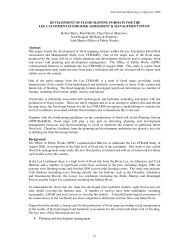COMMENT ON ESTIMATION OF GREENFIELD RUNOFF RATES ...
COMMENT ON ESTIMATION OF GREENFIELD RUNOFF RATES ...
COMMENT ON ESTIMATION OF GREENFIELD RUNOFF RATES ...
You also want an ePaper? Increase the reach of your titles
YUMPU automatically turns print PDFs into web optimized ePapers that Google loves.
National Hydrology Seminar 2003<br />
Tony Cawley<br />
A comparison between the two methods is presented in Figure 1 showing proportional error against<br />
Catchment Area for the IH 124 Data set.<br />
3.5<br />
BA<br />
R<br />
/Q<br />
P<br />
R<br />
O<br />
P<br />
O<br />
RT<br />
IO<br />
N<br />
3<br />
2.5<br />
2<br />
1.5<br />
1<br />
0.5<br />
IH 124 (EQN 17)<br />
ALTERNATE<br />
(EQN 19)<br />
0<br />
0.89 1.6 2.5 3.1 4.4 6.5 8 9.1 10.612.413.315.416.418.619.920.721.121.72 24<br />
AREA<br />
2 )<br />
(KM<br />
Figure 1 Error comparison between IH124 and alternate flood estimation equations<br />
The mean annual maximum runoff rate for different catchment sizes and soil classes are presented in<br />
Table 4. Significant difference exists between both equations when applied to the small catchment<br />
sizes (100 ha and lower) and to higher soil classes (Class 2 and higher).<br />
In conclusion the poor representation of lower soil classes in the sample and the sensitivity of the<br />
regression equation when either three additional catchments of the lower soil types or an alternate<br />
minimisation function are included seriously questions of the validity of the IH 124 equation to small<br />
catchments and also for soil classes 1 to 3. SOIL Classes 1,2 and 3 are the most common categories<br />
for Ireland and particularly in the low-lying urban centres. This method also retains the 1975 FSR<br />
poor resolution mapping to describe the estimation parameters, which is not appropriate for small<br />
catchments.<br />
3.3.4 FEH Method of Design Flood Estimation<br />
The statistical flood estimation procedures in the Flood Estimation Handbook (NERC, 1999), are<br />
largely based on the index flood method, Q T = Q index . X T where X T is a growth factor. However, the<br />
details of implementation have changed from those of FSR. The median annual flood (= 2 year return<br />
period flood) is used as Q index instead of mean annual flood. X T is obtained individually for each<br />
project location from a pooled analysis, based on L-Moment techniques, of data from catchments<br />
which are most similar to the project catchment rather from a single growth curve for each<br />
geographical region.<br />
In the case of ungauged catchments Qmed is estimated from catchment descriptors, relating to<br />
catchment size, wetness, soils and lakes, i.e.<br />
SAAR 560<br />
QMED rural = 1.172 AREA<br />
( ) 1.<br />
AE 2.642 SPR HOST 211<br />
1000 FARL ( ) 1. 0.098 REHOST (eqn 21)<br />
100<br />
Where<br />
AREA = catchment area<br />
SAAR = standard average annual rainfall (1961-90)<br />
FARL = flood attenuation by reservoirs and lakes factor<br />
37

















